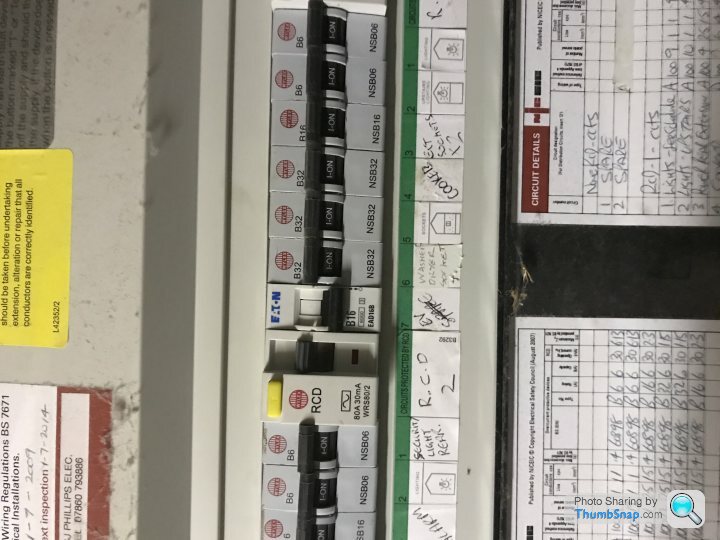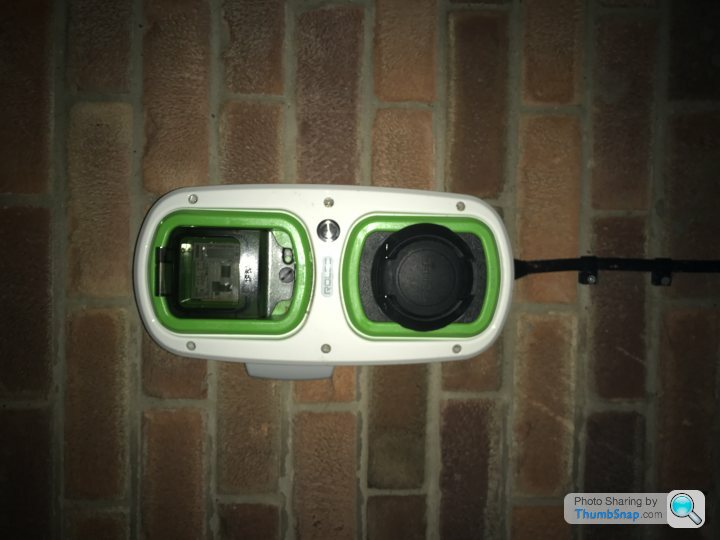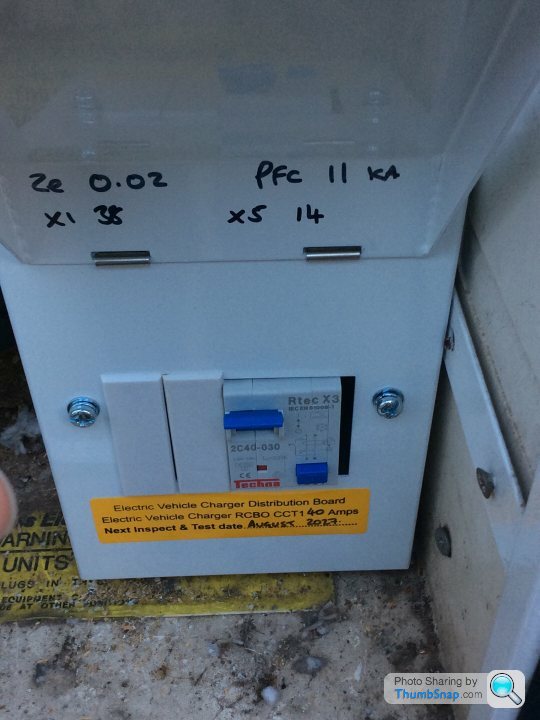Is my home charge point done right?
Discussion
So about a year ago we got a charge point installed. We were part of a trial, we got an eGolf for 3 months and as part of that, we had a charger installed also. We no longer have the car, but we do have the charge point still. Now since the car went, it’s just been switched off at the distribution/fuse box.
But I noticed the other day whilst looking at the distribution box that all my house circuits have 32 amp RCDs but the Charge point has been installed with a 16 amp one.
I don’t know the ins and outs of these things but to my mind, that means the max power you can pull through it is <4kw? (16x240). Type 2 is 7kw so surely they should have put a 32 amp fuse in the box?
Presumably as it was a OLEV project, run by TRL and further muddled by employing really disorganised, almost fly by night, charge point installers, they’ve cheaped out in some way on the installations.
But I noticed the other day whilst looking at the distribution box that all my house circuits have 32 amp RCDs but the Charge point has been installed with a 16 amp one.
I don’t know the ins and outs of these things but to my mind, that means the max power you can pull through it is <4kw? (16x240). Type 2 is 7kw so surely they should have put a 32 amp fuse in the box?
Presumably as it was a OLEV project, run by TRL and further muddled by employing really disorganised, almost fly by night, charge point installers, they’ve cheaped out in some way on the installations.
Edited by Otispunkmeyer on Sunday 6th January 19:11
FurtiveFreddy said:
An RCD isn't the 'fuse' (or circuit breaker).
It doesn't have to be the same rating as the circuit breaker.
A spark will no doubt be along soon to explain in detail.
Hopefully, this sort of thing is something I need to understand more about. I am taking about the box in the garage with all the little breaker switches on, that you’d go to if something tripped your downstairs light circuit for example.It doesn't have to be the same rating as the circuit breaker.
A spark will no doubt be along soon to explain in detail.
Th box they installed is a Rolec one. It’s got its own breaker unit inside as well. I should go have a look at it.
Downward said:
When I had mine fitted their was the option of the 3.3kw or 6.6kw version 16a or 32a.
32a is more expensive comes with thicker cable etc and mine is wired directly to the exteral power supply with a fitted Fuse their not in the distribution box.
The cable supplying the box, doesn’t look too stout I must say. I did think it would be thicker. It’s probab about the thickness of my index finger (and I have boney hands). We didn’t get an option on the install. They just came and fitted it.32a is more expensive comes with thicker cable etc and mine is wired directly to the exteral power supply with a fitted Fuse their not in the distribution box.
Well, actually they turned up and fitted it to my 92 year old, house bound, neighbor. Then when the we told them the car had arrived but we didn’t have a charger they were scratching their heads a bit! I do suspect they’ve fitted the cheapest possible thing that wasn’t just a 13 amp socket. They did need the telematics for the charging data.
Edited by Otispunkmeyer on Sunday 6th January 19:19
Otispunkmeyer said:
Hopefully, this sort of thing is something I need to understand more about. I am taking about the box in the garage with all the little breaker switches on, that you’d go to if something tripped your downstairs light circuit for example.
That's commonly referred to as a 'consumer unit' and usually has a combination of circuit breakers (MCBs) and RCDs in it.The RCDs trip if a leaking current is detected i.e. you touch a live wire.
The MCBs trip if the current drawn is excessive i.e. wires short together.
I think you're expecting the amount of current necessary to charge an EV to require a big thick cable such as the ones dangling from electricity pylons. They don't. Look at the cable on a Tesla supercharger. It's not actually that thick and most of it will be insulation and protection.
The Rolec chargers get mixed reviews, but they aren't necessarily the shoddiest on the market.
Edited by FurtiveFreddy on Sunday 6th January 19:23
The Rolec type 2 wall pods are normally 3.6 or 7.2kW. As said, 16A is fine for a 3.3kW and 32A for a 7.2kW.
I opted for a 7.2kW when I had mine put in even though the car can only charge at up to 3.6kW. Never know what I might get in the future.
There isn’t a fat lot inside them, just a contractor, an RCD and a small comms unit to tell the car how much current it can take as a maximum. I normally set mine to charge at a very low rate for a number of reasons. Firstly, it only has a tiny battery (6.5kWh), secondly, I have solar PV and a Powerwall so like to keep the demand down where I can so it remains within the capacity of the PV if possible (assuming the sun is out or the PW is charged) and lastly, no need to draw larger currents if I don’t need to, so as I never need it to top up quickly (relatively speaking) I opted for the lowest charge current the car does, about 1.8kW. I figure it’s kinder to everything in the entire system from wiring to batteries.
I opted for a 7.2kW when I had mine put in even though the car can only charge at up to 3.6kW. Never know what I might get in the future.
There isn’t a fat lot inside them, just a contractor, an RCD and a small comms unit to tell the car how much current it can take as a maximum. I normally set mine to charge at a very low rate for a number of reasons. Firstly, it only has a tiny battery (6.5kWh), secondly, I have solar PV and a Powerwall so like to keep the demand down where I can so it remains within the capacity of the PV if possible (assuming the sun is out or the PW is charged) and lastly, no need to draw larger currents if I don’t need to, so as I never need it to top up quickly (relatively speaking) I opted for the lowest charge current the car does, about 1.8kW. I figure it’s kinder to everything in the entire system from wiring to batteries.
Gassing Station | EV and Alternative Fuels | Top of Page | What's New | My Stuff






